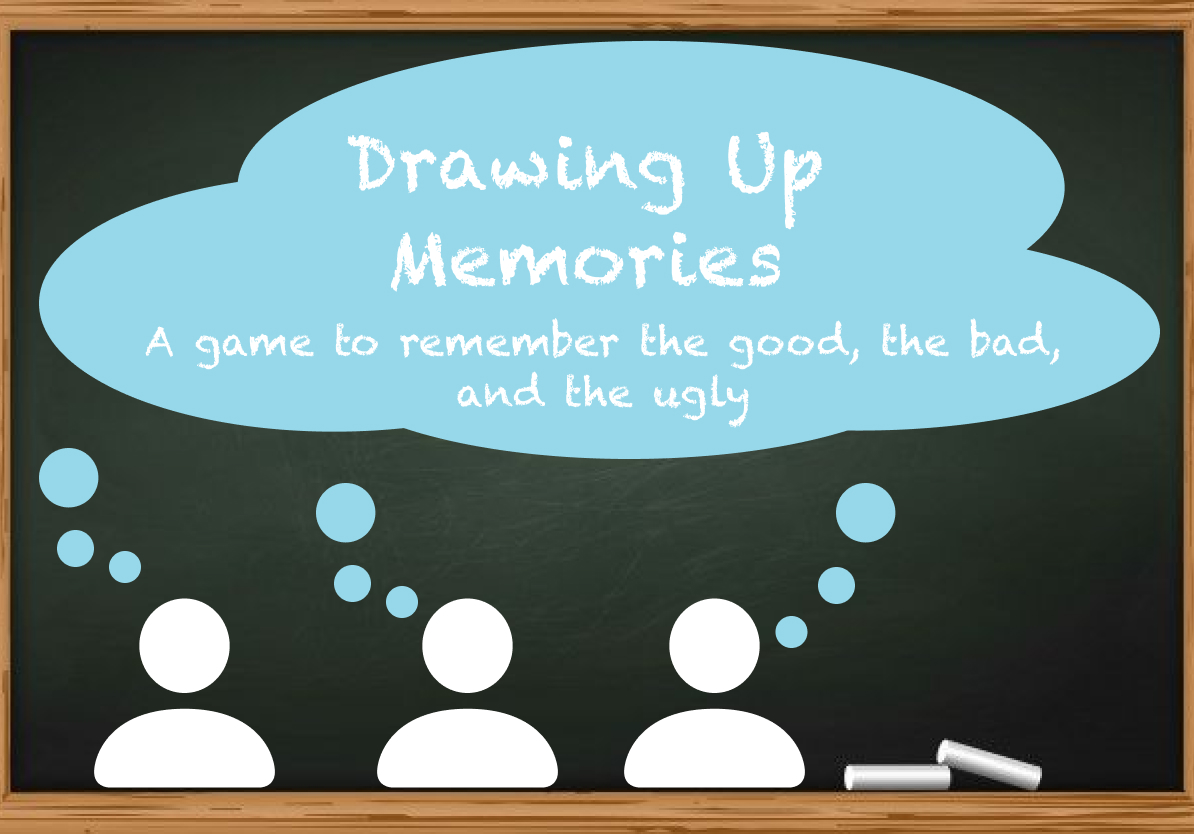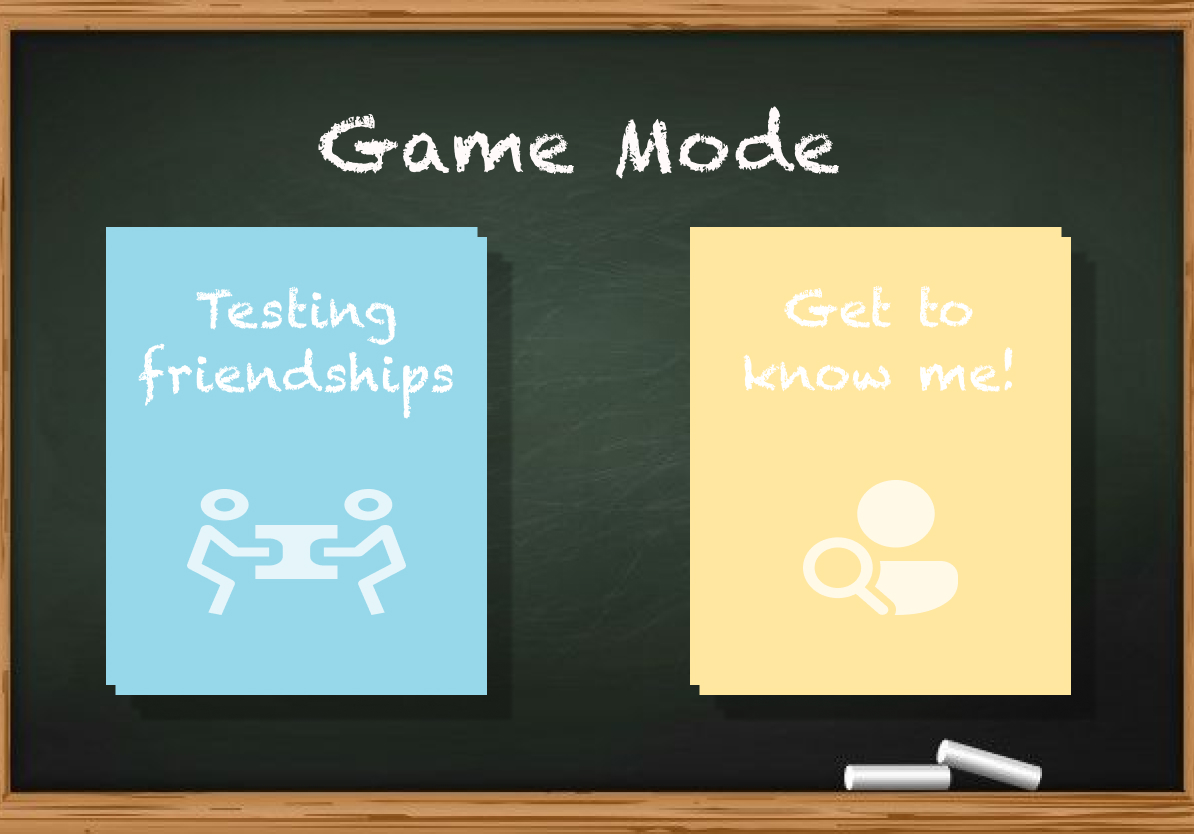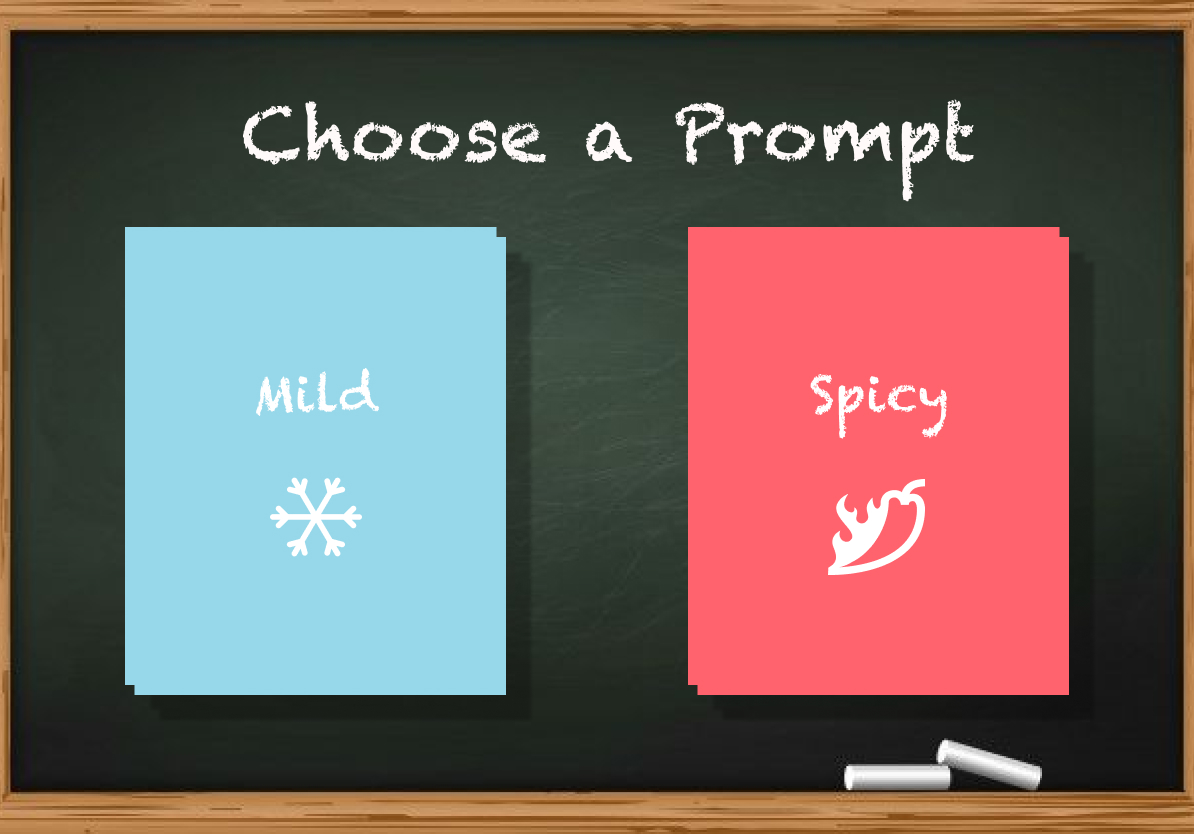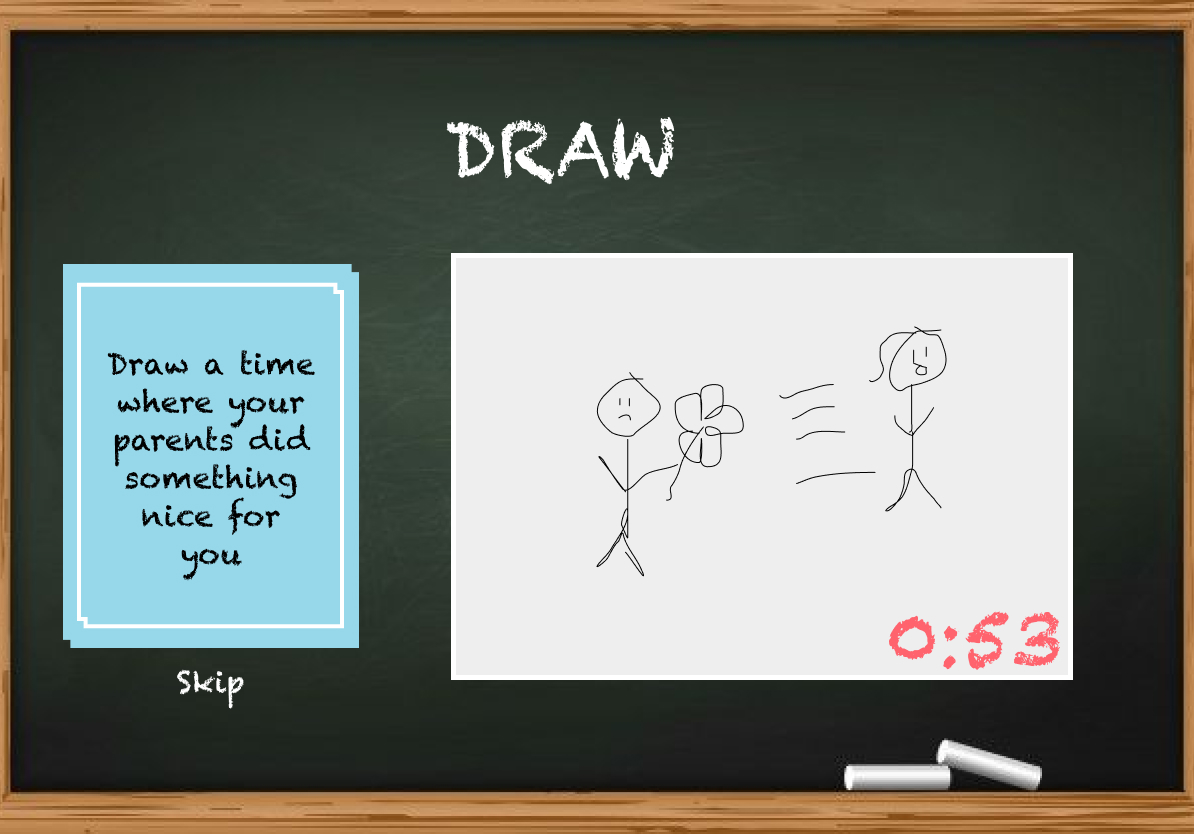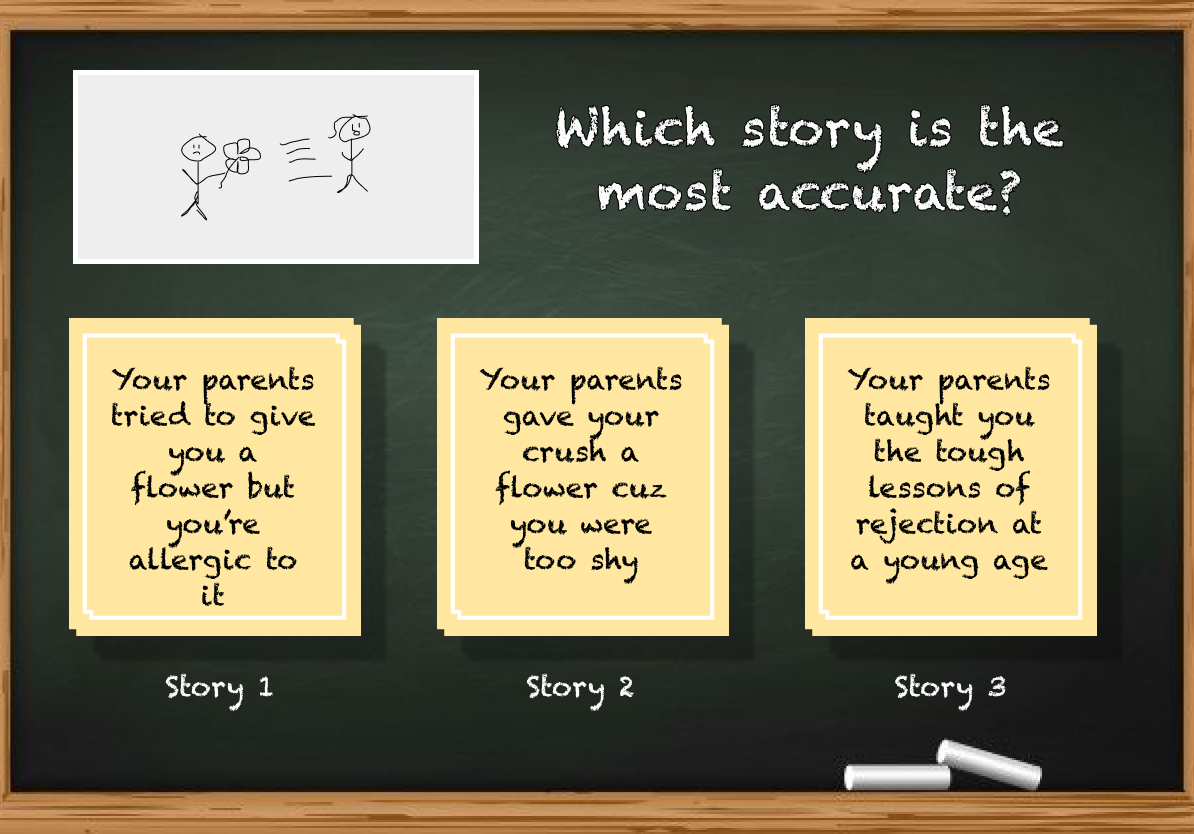Artist Statement
When we first designed this game, we came in with the intention of helping friends strengthen their existing bonds. Over the course of our lives, we develop memories with specific people, yet the time we spend reminiscing on those memories is limited. To solve this issue, we present Drawing Up Memories. The game allows players to test their friendships and see if the memories that pairs share are equally valued and memorable.
As we playtested, the key features of our game — memories and stories — have allowed us to develop gameplay suitable for strangers. In this alternate mode, players will still draw memories related to a given prompt, but these drawings are used to construct fun narratives. We hope the “strangers edition” will allow groups of people to get to know each other based on their histories, rather than just their current appearances. From this, we hope to facilitate the creation of new relationships and bonds that dive deeper into one’s true being.
Brainstorming:
We started our design process by brainstorming individually and seeing where our ideas crossed. We explored the potential of each design and made some branches off our original concepts. When we first started brainstorming, many of our ideas revolved around particular game mechanics or actions that players could take. From there, we came up with our original idea, “Drunken Memories.”

Drunken Memories: The Original Proposal
Our original idea was to make Pictionary into a drinking game to revive old memories between friends. We wanted to focus on the bonds that friends have, while also giving opportunities for players to express themselves through art. Everyone has a different perception of a memory, even the ones they share.

Concept Map
Formal Elements of Drunken Memories:
Players
When we originally designed this game, we wanted to create an intimate experience between friends. Thus, our game required at least two teams with at least two members each. We believe that groups of friends are likely to share the same memories (or will have heard the stories from their friends). Players will primarily be interacting with people on their team. Because the original design was a drinking game, our target audience was adults (21+).
Objectives
The overall objective of each team is to gain 15 points in order to win the game. To win points, teams must work together to guess the memory being drawn that is related to the prompt.
Artist: Your goal is to draw a clear picture of a memory that you share with your partner that is related to the prompt you pulled.
Rest of Team: Your goal is to guess the memory that is being drawn. You want to guess the memory with enough detail to distinguish it from other events and make it clear to everyone that you can recognize the memory.
Extra Objective: With all alcohol-related games, there is the goal to not die of alcohol poisoning. We encourage all players to drink responsibly (and even elect not to drink as we will discuss in our iteration process.)
Outcomes
This game is a zero-sum game. A player will either lose or win. However, we personally believe that the strengthening of friendships is a win for everyone playing!
Procedure
Since our game has evolved dramatically throughout our iteration process, we have linked our original set of rules and procedures here. The concept is very similar to Pictionary. Note that our original design was based on an in-person environment, making it easier to draw quickly. This explains the short drawing times/quick rounds.
Boundaries
The Magic Circle of our game is the room that you are playing in. As we designed our game to be played in person, the Magic Circle is physically just a table or a single room. However, players can also play over zoom. Mentally, the Magic Circle branches into aspects of our past as players try to recall memories related to the prompt.
Conflict
The number of conflicts is relatively minimal. There does exist the conflict between teams as they try to reach 15 points first. Alcohol also poses an obstacle. As players become more intoxicated, it becomes harder to remember memories, and drawing abilities are impaired.
Resources
The only resources present are the points required to actually win, and the prompt cards that determine how each round may go for a given team.
Iteration and Change
April 8,2021 – Krishnan and Friends Playtest
This playtest mostly tested the game’s initial mechanics. We wanted to see if there were any major flaws in logic or if users struggled to interpret the rules of the game.
What went well: This playtest proved that people did like the idea of the game. Responses to the game were filled with laughter as players tended to reminisce about the more humorous memories they shared.
What didn’t work: A couple of our prompts did not apply to all members of the group. One of our playtesters was LDS, meaning that she did not drink or have any experience using drugs. As a result, the question “Draw your drunkest memory” brought around some discomfort and confusion. It is unclear what must be done if a prompt does not apply to a player or pair.
Another central component of our game that quickly came to be problematic was the concept of drinking. In our game, drinking is used as a punishment if a team is not able to guess the memory in the allotted time. However, with an LDS playtester, drinking brought around discomfort. Furthermore, we saw that the playtesters who did drink were going to drink even if they got the answer right. Drinking was not being viewed as a “consequence” in this case, making it obsolete.
Finally, we playtested the idea of constraints in this game, including drawing with your non-dominant hand or drawing blindfolded. We found that many of the constraints we proposed were imbalanced and didn’t deserve to be contributing the same amount of points. Additionally, the constraints took away from the goal of reminiscing about memories as players became increasingly frustrated despite trying to draw up positive memories with their partners.
Changes made:
- We have decided to improve our prompts in order to be more generalizable to our audience. For example, rather than asking players to “Draw the drunkest memory they share with their partner”, we ask players to “Draw a time where you and your partner were not thinking clearly”. We want this game to be as inclusive as possible.
- We have decided to abandon the idea of using constraints when drawing memories. We believe that the constraints retracted from the emotion of nostalgia and instead evoked feelings of frustration.
- At this point, we have not removed drinking from the game. We wish to explore this concept more in other playtests before making a clear decision.
April 9, 2021 – Jacob and Friends Playtest
This playtest also focused on early mechanics. Our goal was to validate the prompts and test the mechanics of drinking as a consequence.
What went well: We found that the players enjoyed the game. The prompts did their job of evoking memories between partners and giving them a chance to reminisce.
What didn’t work: By playtesting over Zoom, we learned that the time limits designed for in-person gameplay were not feasible for an online environment. The drawing mechanics online are clunkier and take significantly longer to make clear.
Additionally, we found that the prompts in this round needed improvement. In contrast to the previous playtest, players here found some of the prompts too general or ambiguous. These included prompts such as “Draw a time where your partner made you happy.” Prompts such as this made it hard to pinpoint a single memory. Several players also asked if “this memory counts,” a question that we did not have a direct answer to.
Changes made:
- Due to the lag and lack of dexterity associated with online drawing, we have decided to increase the drawing time of the game from 30 seconds to 60 seconds. We believe that our target audience will be playing this game online until the end of the pandemic at least, so it is best to optimize our design to an online environment.
- We have decided to make some of our prompts more specific to reduce the ambiguity that our players experience. For example, instead of asking players to “draw a happy memory with your partner” we have surrounded the prompt within a certain context. Thus players will be asked to “Draw a memory where your partner did something nice for you” or “Draw a memory where your partner cheered you up”. We believe that these prompts will make it easier to identify specific memories within a time crunch.

April 11, 2021 – Rhett and Friends Playtest
This playtest focused on the mechanics of drinking rather than the individual prompts. This was one of our bigger playtests, so we were also able to identify the differences between pair and team-based play.
What went well: The players reported that the rules were very understandable and found that they. could apply their mental model of Pictionary to this game, which was a huge win for us! Rhett, as the moderator, did not feel the need to intervene to clear up any confusion.
What didn’t work: This playtest truly revealed the flaw of drinking in our game. As players drink, the game becomes less about reviving memories and more about alcohol consumption itself. Our playtesters were college students who wanted to unwind and get tipsy without obstacles. Players would drink regardless of earning a point or not. Additionally, the players were friends, so alcohol was not serving as a social facilitator or loosening agent. Finally, the intoxication of players ruined some of the other game mechanics. The time limit became impossible to manage when intoxicated and drawing became increasingly worse, which took away the ability to draw up memories. Another issue that arose was the fact that drawing and thinking of a memory were both time-consuming events. For more difficult prompts, players spent an extended time thinking, and therefore did not have enough time to draw their memory cohesively.
We also found that team-based play was possible but only in a few scenarios. Many of the memories drawn up by the group were not shared by all members, making some people feel left out.
Changes made:
- At this point, we have decided to completely remove drinking from our game. We want to stay true to the emotions we are trying to evoke (nostalgia), and alcohol comes into conflict with this goal.
- We have decided to change the rules to restrict teams to 2 people. We believe that this will provide a more intimate interaction between players and allow all players to feel included in each round. Our fear with this change is that there will be an increased wait time between drawing if there are more teams.
- We have decided to implement an additional 15 seconds prior to the drawing period to allow the artist to think of a memory. The 60 second drawing period is ideal for prompts that are direct and quickly evoke memories. A good comparison would be Pictionary, where players do not spend much time thinking about how they can draw the prompt. However, since our prompts evoke memories rather than distinct objects, they warrant an additional buffer period to think.
April 13, 2021 – Class 3A Playtest
This playtest focused primarily on the prompts themselves. We had playtesters simply think of a partner in their mind. For each prompt they were presented with, they were instructed to think of a memory that they could draw with that theoretical partner in mind. This decision was based on the fact that our playtesters did not know each other well enough to have any shared memories.
What went well: Playtesters reported that the prompts were well worded and clear about their expectations. Playtesters also enjoyed the diversity in the types of prompts. One stated, “I like how some of the prompts flip the tables by asking what you think your partner thinks about you.”
What didn’t work: Our major issue this round was that some memories felt too intimate or personal to share with a group of strangers. This included prompts that produced memories of tensions such as “Draw a memory where your partner made you angry.” We did not anticipate this problem as our game was originally designed to be played amongst close friends. We are looking to examine this complaint in future playtests.
Another issue that arose is that friendship is a spectrum. Although the majority of our playtesters chose their partner to be someone they are extremely close to (ex. a romantic partner), one player imagined someone they had recently become friends with. They found that some of the prompts such as “Draw a time where you traveled with your partner” indicated that the friendship must be far beyond acquaintances. This is not something we originally thought about.
Changes made:
- From this playtest, we have not decided to make any drastic decisions. We decided that further playtests would be needed to analyze the discomfort associated with friend dynamics that are not as close. However, this playtest was our original push to consider our target audience and if this game would be fun only for close friends.
- We did modify some of our prompts slightly to account for less developed friendships. For example, when asking players to “draw a time where you traveled with your partner”, we extend the prompt to say “even if it was just to the grocery store.” By extending certain prompts, we are able to generalize our prompts regardless of one’s relationship, along with financial or social circumstances.
April 15, 2021 – Class 3B Playtest
After revising our prompts, we were able to finalize many of them. We used the same style of playtesting as the class 3A playtest above.
What went well: Playtesters reported a positive balance between specificity and ambiguity in the new set.
What didn’t work: Our playtesters were slightly concerned about becoming disengaged as other teams were drawing. This is particularly possible if the other team was not involved in the memory at all. Players wanted to be more involved during the entire process, rather than only when their team was drawing and guessing. Our playtesters also recognized an imbalance in the types of prompts being presented. Some were very easy to draw without any discomfort such as “Draw a time where your partner made you laugh.” However, some brought around hesitation since players were unsure if they wanted to share this memory with the entire group or even remind their partner of the situation. This includes prompts such as “Draw a time where your partner let you down.”
Changes made:
- We were surprised by how involved our playtesters wanted to be in the revisions process. They helped us brainstorm a lot at this stage. One suggestion made by our playtesters was allowing the opposing team to guess the memory if the drawing team fails to win the point. We determined that this would be a valid game dynamic as most friend groups will tell stories to all members, regardless of who was there. To make this fairer, the opposing team should at least be able to see the prompt, since there is a large possibility that they are not involved in the memory. If players are not able to see the prompt, it would be far too difficult to guess the memory with much accuracy.
- The playtest also resulted in the production of two prompt decks. One would be labeled “spicy,” which includes prompts that provoke more tension or awkwardness, and the other as “mild,” which tend to be more positive and easier to share. We believe the division of our prompts will provide players with more autonomy in choosing the type of game that they would like to play. In order to ensure that players are rewarded for choosing more difficult prompts, we have decided to implement a tiered point system. The “mild” prompts are only worth one point, while the “spicy” prompts are worth two points.
April 18, 2021 – Ethan LeBlanc and Friends Playtest
This playtest was played without an active moderator. We did not want to intervene and simply wanted to observe the interactions like a fly on the wall. The playtest was a full game including the revisions we had made before this point.
What went well: We were happy to see that the rules did not require any additional explanations. Players thoroughly enjoyed the spicy and mild deck as it gave them more autonomy. The 1 point difference was found to be effective in encouraging players to draw from the spicy deck. Many also chose to draw from the deck simply to make the game more entertaining or to be audacious.
What didn’t work: This playgroup was not as close as they originally thought. They struggled to generate memories for prompts that we would consider applicable to average friends (ex. Draw a time where your partner cheered you up”). The group also did not feel as if they could draw many of the spicier prompts, demonstrating how those prompts are typically designed for closer friends rather than college students who have only known each other for a year.
One aspect that didn’t go well nor fail was having the opposing team guess the memory if the drawing team were to fail. Although it did keep the opposing teams engaged, occasionally they could only construct a creative narrative rather than pinpoint the memory exactly. We wish to explore this dynamic in further playtests and explore alternatives to keeping the opposing teams engaged.
Changes made:
- This playtest encouraged us to explore the idea of a game with the same mechanics designed for strangers. This type of game would allow players to get to know each other from scratch, without the need for a shared history. We wanted to create this alternate version in order to make our game more inclusive of friends across the entire spectrum. We expand on the stranger’s version of the game in the Class 4A playtest.
- In order to safeguard players who are uncomfortable with exposing certain memories or drawing certain prompts, we have included a finite number of skips (3) that players can use to avoid certain prompts that are drawn.
April 20, 2021 – Class 4A Playtest : Strangers Mode
Inspired by our previous playtests, we decided to generate an alternative form of gameplay designed for strangers. Our Strangers mode adopts many of the game mechanics of our pair-based game. Players will still be drawing memories based on prompts. However, these prompts are designed to evoke memories for individuals rather than between pairs. The prompts are situations that everyone has experienced. This includes “your first crush” and “a time where your parents did something nice for you.”
Although both the Strangers mode and Friends mode of the game focus on the fun of self-expression and fellowship, the Strangers edition accomplishes fellowship in a unique manner. Rather than trying to revive old memories to strengthen an existing bond, the Strangers mode allows players to get to know each other on an intimate level, creating a new bond. One’s memories often serve as a representation of who they are as a person, providing an avenue for players to look far beyond appearances.
Before explaining the playtest, here is a brief explanation of how Strangers mode works.
- One person will draw a card from the Strangers deck. These prompts are designed to introduce players to each other in an intimate way based on the past. These prompts are similar to icebreaker questions.
- After drawing, the player has 15 seconds to think of a memory, and then 60 seconds to draw their memory.
- As the player is drawing the other players will start to guess the memory with as much detail as possible. When the artist deems that enough detail has been reached, the player with the most accurate guess wins.
- The artist then switches and the process repeats.
What went well: This was our first in-class playtest that felt like a game. Our playtesters reported feeling joyous and nostalgic as they learned about each other’s histories. We also saw that players were able to open up to each other through drawing. Since the memories were framed as a game, it felt safer to share, even with people that they hardly knew.
What didn’t work: When playtesting the Strangers version, we learned that many of the game mechanics from the original version did not carry over. The first failure was having all players guess as the artist was drawing. This failed because players did not have the freedom to interpret the drawings from a unique perspective. As players guessed, they converged down a single path, making it difficult to reach the right answer if they strayed off early. Furthermore, it was hard to determine when to end the round, as the specificity of the memory is ambiguous.
Quick Revision: After realizing that players could not guess the memory simultaneously due to the lack of a clear answer threshold and the lack of independence, we decided to slightly alter our game in the middle of this playtest. In the second half of the playtest, we decided that players would instead observe for the 60-second drawing period. They would not be allowed to guess or speak at this time. At the end of the drawing period, the other players would have 30 seconds to write down a story of what they think happened with as much detail as possible. Players who were the closest to the actual memory would win the point.
What went well: Our playtesters preferred creating their own stories independently to the prompts more than the first playtest. They claimed that it fostered more creativity and allowed other players to construct narratives of the artist based on the limited knowledge that they had. They could make the stories as entertaining or bizarre as they wanted. We also found increased diversity in responses, making it easier to distinguish a winner in each round.
What didn’t work: By prototyping the latter procedure, we found that there was too much dead time. Players did not want to wait 60 seconds in order to submit their answers. It felt more like an awkward silence. This version of Strangers mode also struggled due to a lack of objectivity. When two players had similar amounts of accuracy, it was difficult for the artist to break the tie since there wasn’t a clear rubric for them to judge by.
Changes made:
- In order to prevent an exorbitant amount of dead time, we decided that players would all draw the same prompt simultaneously. This would allow players to be active during all points of the game, whether they are drawing, guessing, or judging.
- In order to break ties, judges first judge on the accuracy of the drawing. If multiple players have an equivalent amount of accuracy and a clear winner cannot be determined, the artist will choose based on creativity and personal preference. We believe the two-step judging process encourages guessers to be more creative with their responses rather than simply sticking to the drawing. This makes for more entertaining responses that everyone can enjoy.
April 22, 2021 – Class 4B: The Final Playtest
This playtest was primarily used for video purposes and to finalize our game
What went well: Players really enjoyed the fact that they were all drawing at the same time. They felt like they didn’t have to wait as long to actively participate in the game.
What didn’t work: Although the players were being judged on creativity, some players would only construct narratives with details depicted explicitly in the picture. This resulted in extremely brief responses. For example, one player drew a movie theatre in response to “Draw your first date”. This resulted in a couple of responses that only said “a movie date.” In future iterations, it would be important to find ways to encourage creativity in narratives, either through marketing or through examples to make the norms salient.
Future Playtests
Due to a limited time frame, we do not have the capacity to thoroughly test every single mechanic of this game. However, if we were to continue iterating and playtesting, we would focus on the following factors of our game.
- Skips in Stranger Mode: Since players are drawing from the same deck, it would be necessary to devise a way for players to skip prompts without penalty. We would also need to playtest whether it is fair for those who skip a prompt to earn points during a round, or whether an alternative penalty should be applied.
- Opposing Team Guesses: It is unclear whether it is balanced for the opposing team to guess the memory. In many situations, they are not involved with the memory, and may only hear about it verbally. However, this social dynamic is only common among close friend groups. We are curious as to how we can engage opposing teams for friend groups that aren’t very close. This will definitely require more research and consideration.
Iteration summary:
-
- Iteration 1: The Original Game
- The first implementation of our game had all of the core gameplay mechanics, but the rules of the game were still in their initial stages. It was only possible to play the game with close friends, and the game revolved around drinking –– when a team is unable to guess a memory, all members of the team must drink. We found that drinking did help players overcome a social barrier, so it became increasingly obsolete. There was only one level of difficulty of questions, although the prompts were imbalanced. This made it seem unfair for players as they were forced to skip prompts without the intention of drawing a difficult/personal prompt. Finally, the game was centered around teams of 2-5 instead of pairs. Prototyping revealed that large groups were not ideal because many memories are shared with just one person. Furthermore, each relationship is unique to individual pairs.
- Iteration 1: The Original Game
-
- Iteration 2: Removing Drinking
-
-
- As we did our initial playtesting, we started to realize that drinking did not add much fun to the game, and at points made it harder to stay focused on the game. The biggest issue with removing drinking was rethinking our brand. Our name, type of fun, and general aesthetic all changed as a result of this iteration. Since our game is based on nostalgia, we decided to wrap our design around chalkboards to take kids back to elementary school or playing with chalk outside. We also decided to focus more on the tiered point system rather than the consequence of drinking.
-
-
- Iteration 3: Stranger Mode + Refined Mechanics
-
-
- After lots of missed playtesting due to a lack of shared memories, we finally settled on a solution in the form of a new game mode. With stranger mode, players are able to get to know each other on a deeper level without having any previous context of each other. We want to ensure that players are engaged at all points of game play. Since our prompts should be applicable to everyone, we decided that everyone should draw at the same time, and then create stories to be submitted for judging by the artist (just like Cards Against Humanity).
- For our pair-based game, we refined the game’s rules, adding a rebuttal round, allotted time to think of memories, and a pair-based system (for friend mode) rather than team-based.
-
Final Game:
Through iteration we have transformed “Drunken Memories” into “Drawing Up Memories”. We have linked the procedures/rules and the quizlet with the prompts here.
Final Concept Map
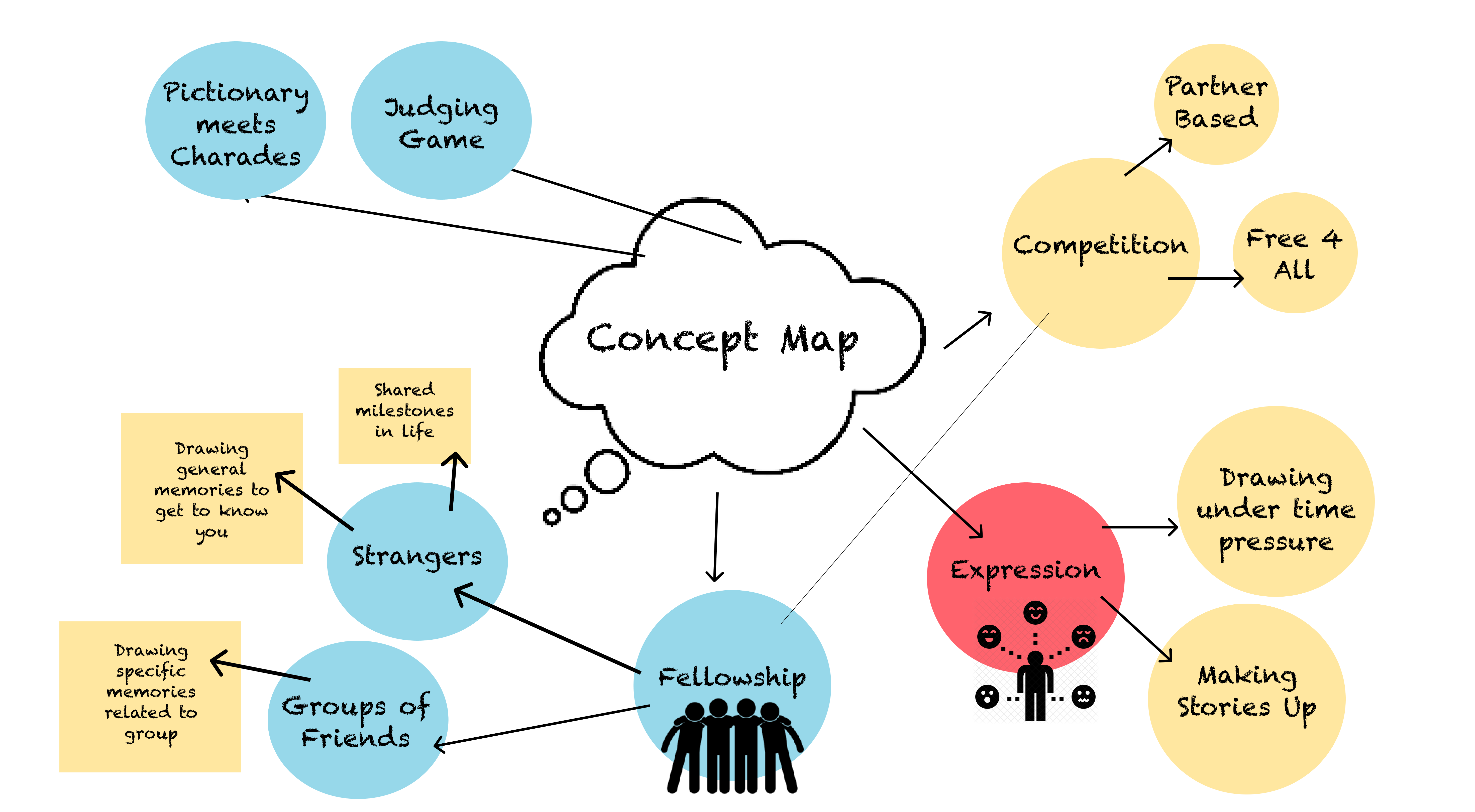
Final Game Flow Diagram
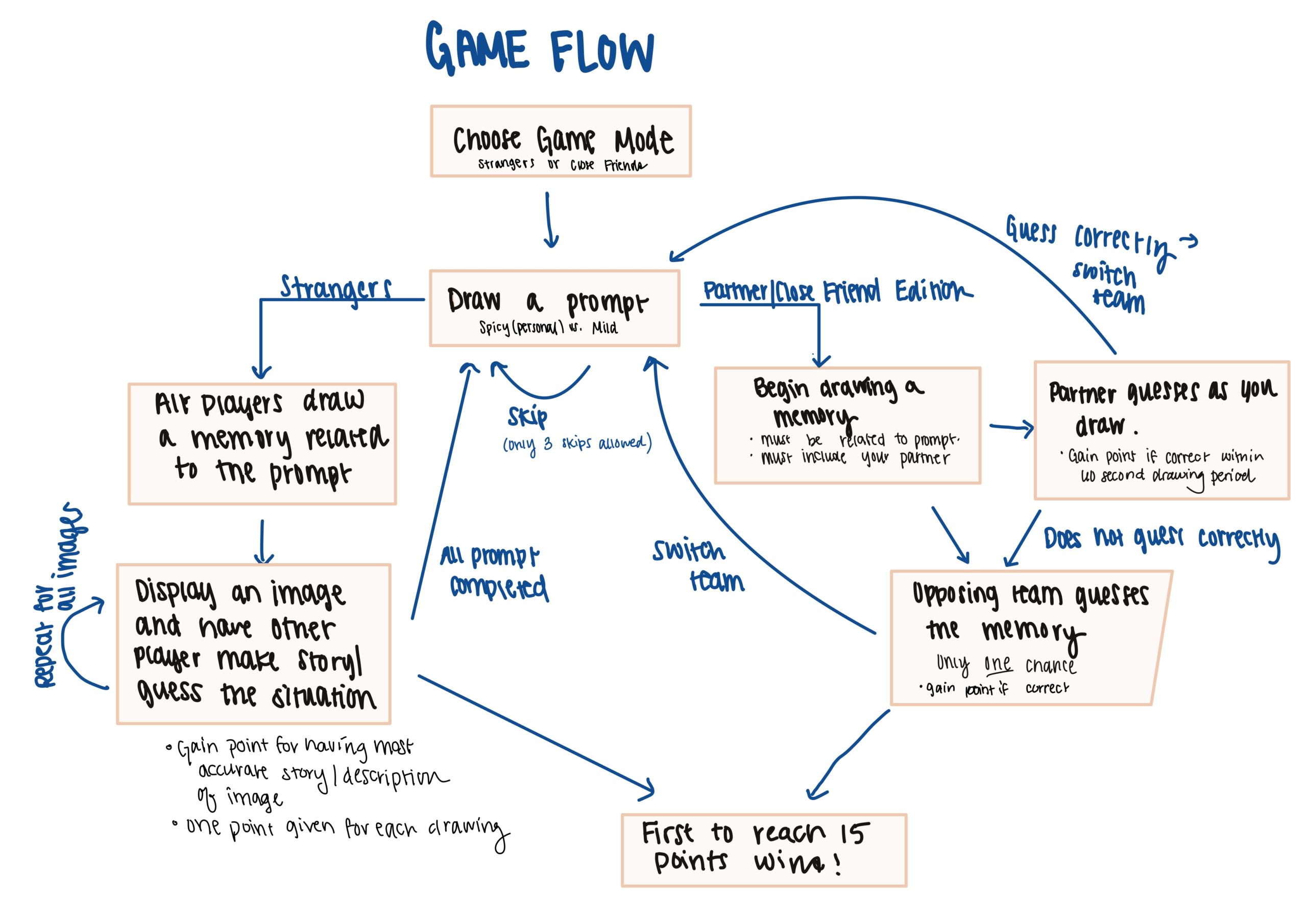
Summary of Changes Made

Types of Fun:
Fellowship: At the heart of our game is friendship. This can be either establishing new friendships via “Stranger Mode” or strengthening old friendships with “Friend Mode”. At the end of the day, we want players to bond with each other through the exploration of old memories.
Expression: Through the act of drawing, players are free to express their memories in whatever form they want. They can exaggerate certain details or minimize certain details. Even the memories that they choose to draw allow users to express their values as they determine which memories are at the tip of their tongues.
Discovery: Instead of discovering different aspects of an imaginary world, players of this game will be discovering different qualities about each other. Through our memories, we can determine the events that have shaped our peers into the people that they are today. We can see the highs and lows of their past, rather than focusing entirely on how they present themselves today. There is more to a person than just their appearance, so we hope players can discover who others truly are.
Aesthetic/Marketing
As we diverged from the idea of a drinking game, we decided to focus our aesthetic on the idea of nostalgia. We hope that the memories that we evoke (whether they are good or bad) will still show people the value their lives have held in shaping them into the person they are today. In order to demonstrate the idea of nostalgia, we decided to focus our aesthetic with a chalkboard. We want to take people back to elementary school (or for the case of many Stanford students, the time that they took Math51 and everything was taught on a chalkboard). We also hope to remind people of the joy of drawing with chalk on a sidewalk as a kid.
Style Tile/Mood Board
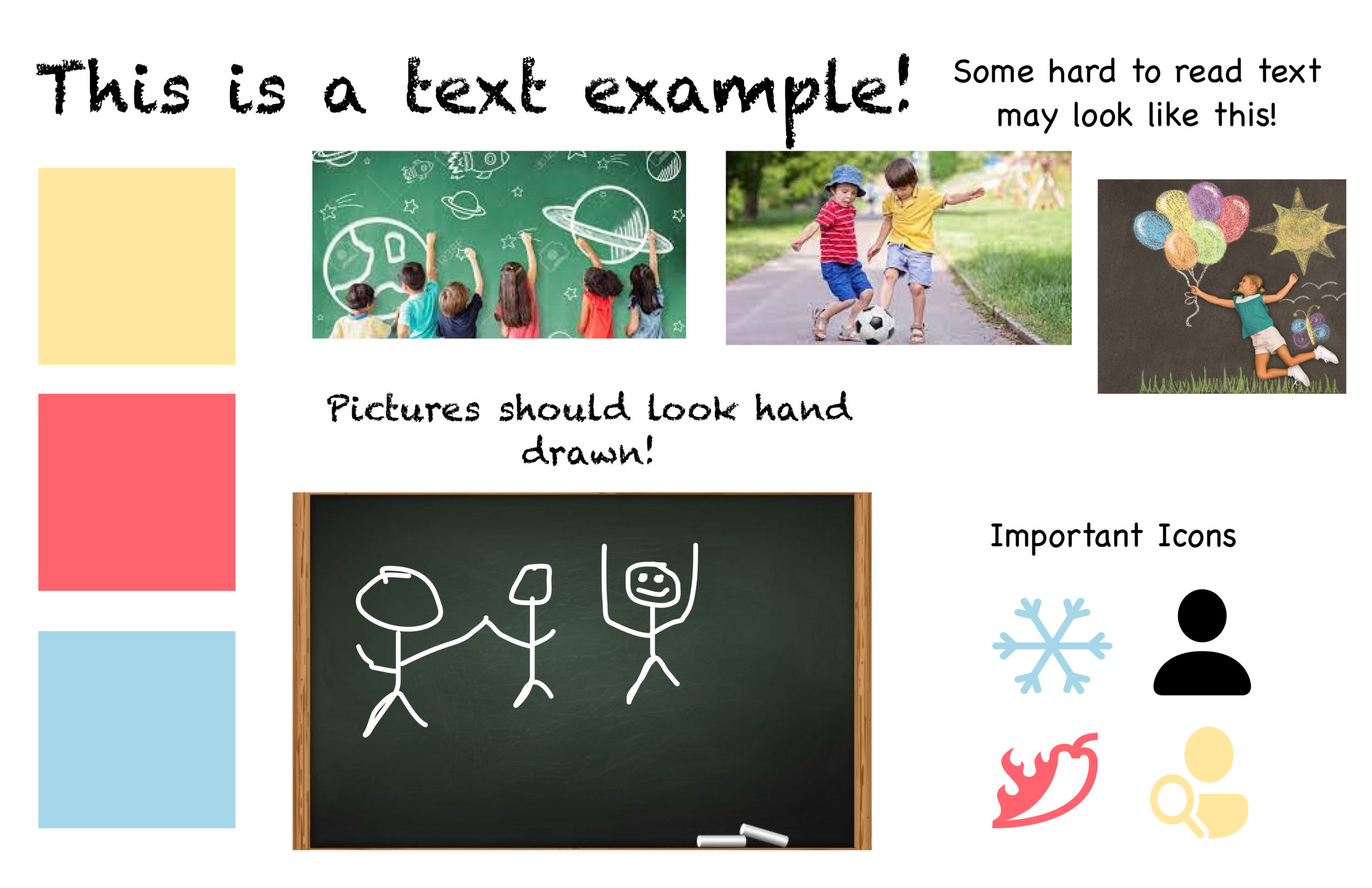
Core Loops: Friends Edition
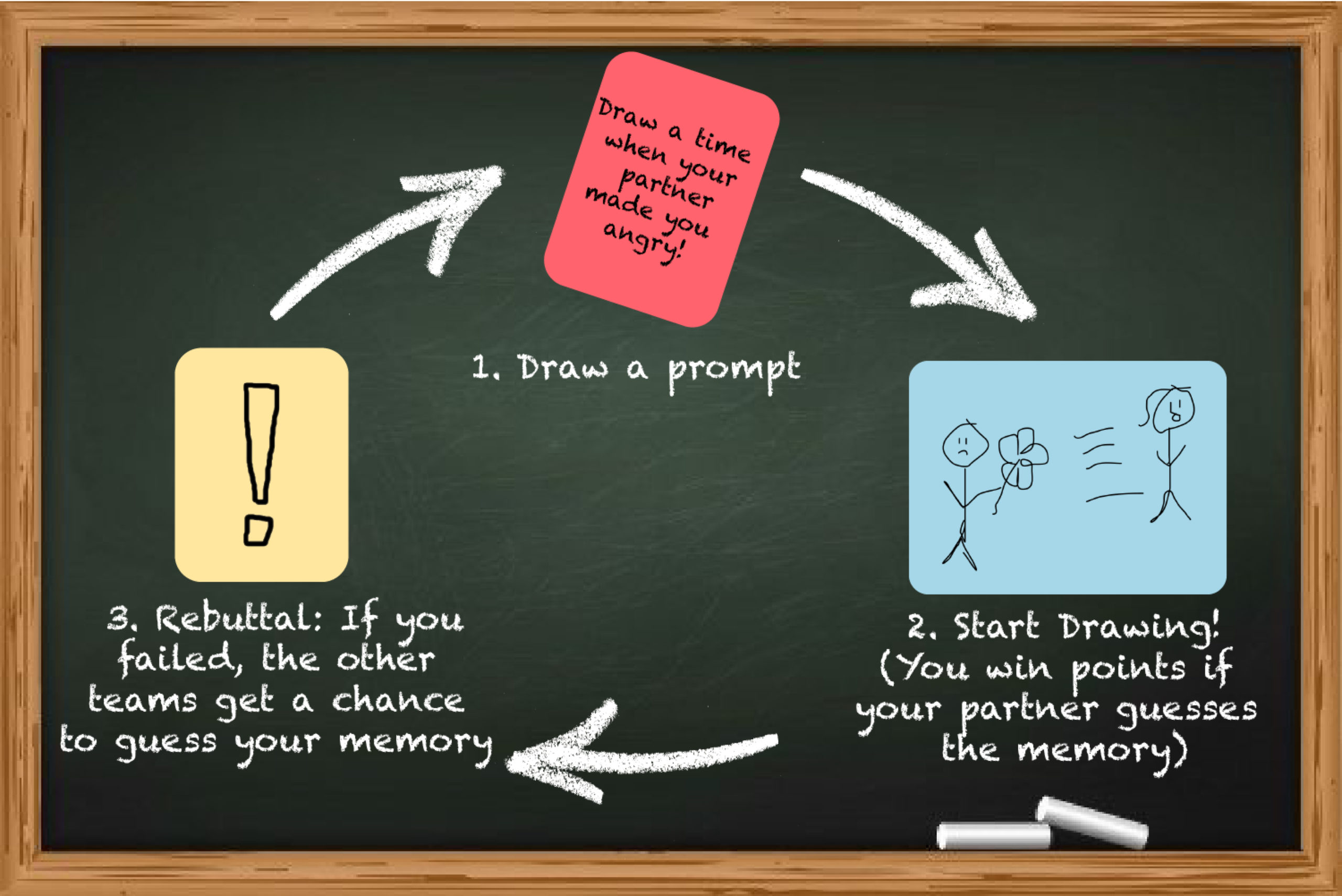
Core Loop: Strangers Editions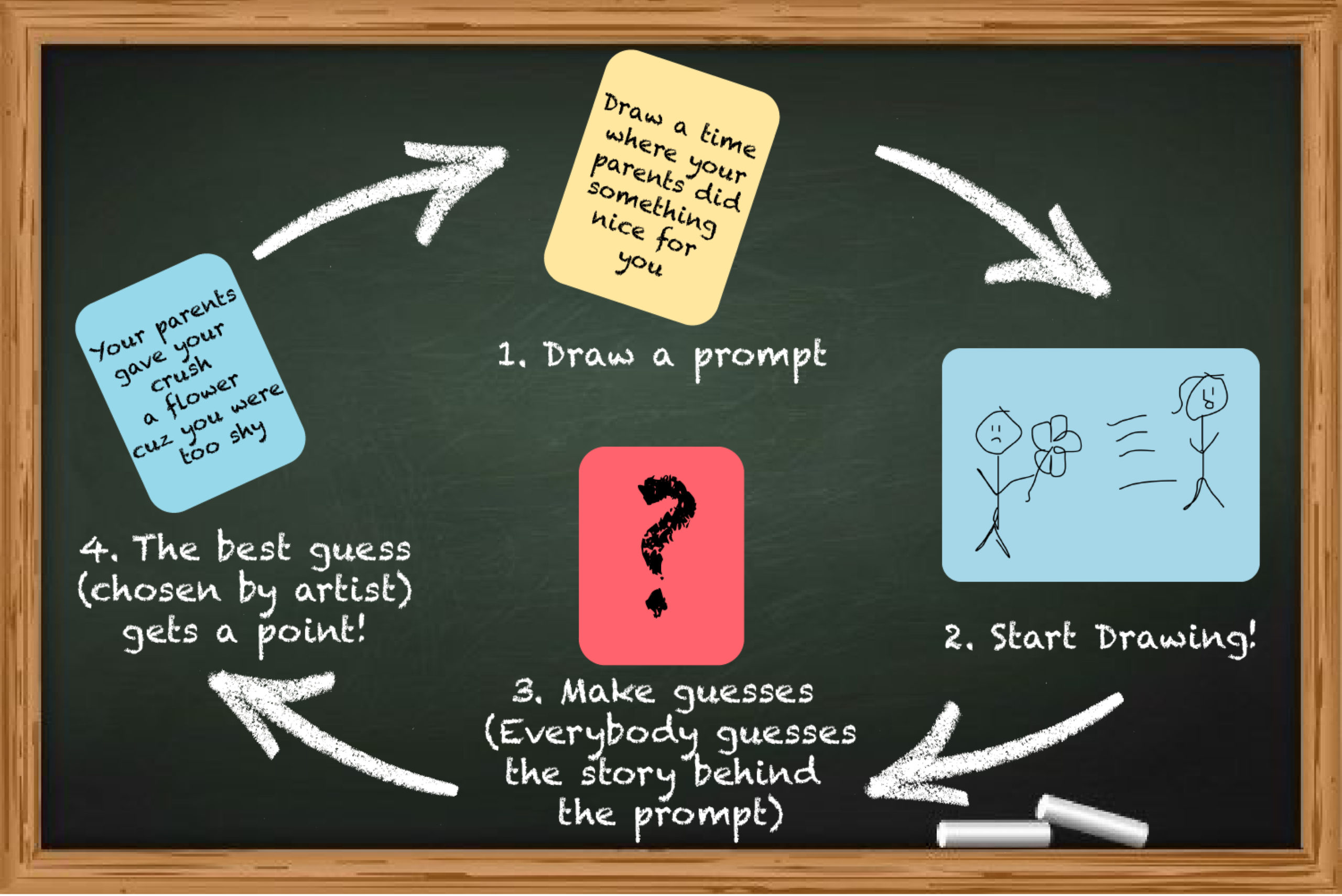
Marketing Materials: Tablet Interface
Playtesting Videos
Strangers: https://youtu.be/qyo2lew8pUM
Friends (going over rules): https://youtu.be/-0NaZR42ZzU
Friends (actual playtesting): https://youtu.be/n28_p37Qa80


